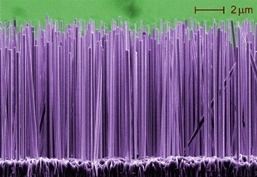
A $6.3-million grant from the Department of Defense’s Multidisciplinary Research Initiative (MURI) will allow a group of faculty researchers involved in two of the University of Notre Dame’s strategic research investments — The Center for Nano Science and Technology and the Advanced Diagnostics and Therapeutics Initiative — to develop new gallium nitride (GaN) based electronic devices that operate in the terahertz (THz) range of the electromagnetic spectrum.
Patrick Fay, along with Debdeep Jena and Huili (Grace) Xing, led the multi-institutional team to secure the highly competitive grant that also includes researchers from Ohio State University, Johns Hopkins University and Wright State University.
The research group receiving the grant includes electrical engineers, material scientists and physicists, each of whom brings different expertise from fields such as semiconductor devices, electromagnetic simulation and design, GaN growth and high-frequency device and materials characterization.
Altough GaN has been previously utilized for its optoelectronic properties in ultra-bright LEDs and the lasers that read Blu-ray Discs, there is still not a firm grasp on its physics. By attaining that understanding, the goal is that new GaN-based devices will be developed, enabling a wide range of new terahertz applications.
Despite also having studied the THz phenomena in the laboratory for years, scientist still lack the ability to generate the high-quality coherent sources necessary, limiting research to very low power levels. Moreover, the current sources are difficult to adapt for sensing systems operating outside of a laboratory, further limiting the ability to utilize all of the unique properties of THz frequency signals.
However, “the ability to generate, receive and process signals at terahertz frequencies can have a potentially significant impact on critical areas such as medical sensing, chemical agent screening, and military imaging and communications,” said Fay, principal investigator for the project, professor of electrical engineering and director of Notre Dame Nanofabrication Facility.
In 2010, Jena and Xing received separate Department of Defense funding through the Defense Advanced Research Projects Agency for a project to create new GaN ultraviolet light sources that can be used by soldiers (and eventually civilians) to purify water in the field, further underscoring the opportunities being created by Notre Dame’s GaN research.
Notre Dame researcher Harindra Joseph S. Fernando also won a $7.3-million MURI grant to develop fundamental knowledge that helps improve forecasting models of weather in mountainous terrain. These models will focus on aviation and defense operations planning in areas of complex topography, paying attention to severe weather phenomena and the nighttime boundary layer of the atmosphere.